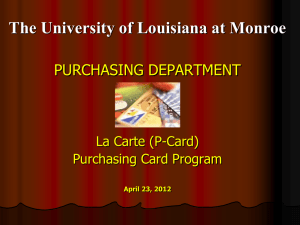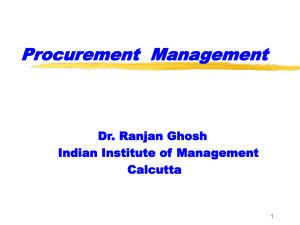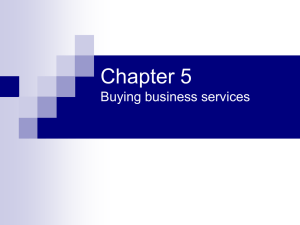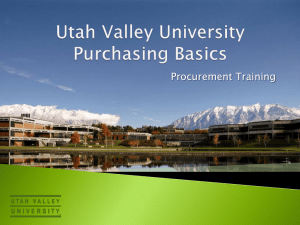Purchasing Card Training - Pennsylvania: Purchasing
advertisement
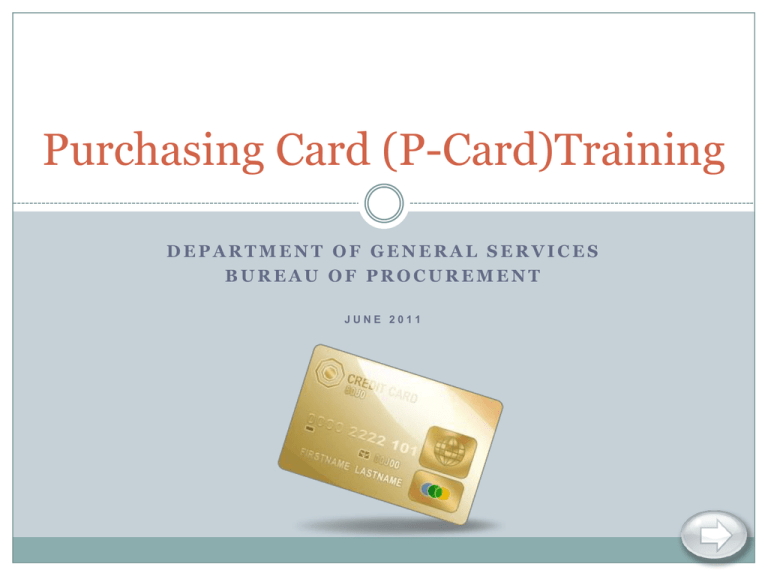
Purchasing Card (P-Card)Training DEPARTMENT OF GENERAL SERVICES BUREAU OF PROCUREMENT JUNE 2011 Course Navigation This course is presented on a series of slides. Navigate through the slides by selecting the NEXT or PREVIOUS button. PREVIOUS NEXT You may exit the course at any time. When you return to the course, you can choose to resume the course or start from the beginning. Select the NEXT button now to start the course. 2 Topics of Discussion Introduction Procedures for Use Issuance Security Change of Cardholder Status P-Card Enabled vs. P-Card Accepted How to Use the P-Card Flowchart of Purchasing- Card Process Policy and Guidelines Overview When can the P-Card be Used? Unauthorized Use of the PCard Approved Usage Unapproved Usage Abuse of Purchasing-Card Responsibilities Records Retention Definitions Reference Material 3 Course Objectives Upon completion of this course, you should be able to: Understand the benefits of using the Purchasing Card. Understand the transaction limit for the purchasing card and how you cannot split purchases in order to circumvent the procurement process. Understand what is an approved usage for the purchasing card; what is not an approved usage; and what represents abuse of the purchasing card. 4 Course Objectives Upon completion of this course, you should be able to: Understand how to properly secure your purchasing card. Understand the difference between Enabled and Accepted. Understand the five methods how a purchasing card can be used in the procurement process. 5 Introduction 6 Purpose The Commonwealth Purchasing Card Program is authorized by Management Directive 310.23 and subject to all subsequent amendments and revisions. Management Directive 310.23 and the Procurement Handbook outline the policies, procedures, and processes that govern usage of the Purchasing Card for the procurement of materials and services by which all purchases must comply. 7 Benefits The Purchasing Card offers many benefits to the Commonwealth and the supplier community. Suppliers are paid within two to three business days of the purchase. Additionally, the Commonwealth receives a 1.47% rebate after a monthly purchase threshold is met, which will increase as spending with the purchasing card increases. This rebate is returned to the Purchasing Cardholder’s organizational budget. 8 P-Card Benefits The Purchasing Card will only affect the Commonwealth’s credit status and not reflect on the Cardholder’s and/or Authorized User’s personal credit history. The cardholder and/or Authorized User are not responsible for payment of authorized purchases. 9 Commonwealth Benefits Reduction/elimination of agency advancement accounts Reduction of paperwork due to electronic transfers Rebates when certain dollar amounts reached Quicker ordering process Quicker receipt of orders POs automatically generated POs auto-faxed to suppliers No Goods Receipts required Invoices do not need to be processed through Comptroller Operations Eliminates blocked invoices Ability to generate data for P-Card reconciliation process 10 Supplier Benefits Immediate payment Less paperwork Faster payment USING THE PURCHASING CARD DOES NOT CHANGE DOCUMENTATION REQUIRED AND APPROVAL PROCESS. AGENCIES CAN STRICLY ENFORCE THESE PROCEDURES. ALL PURCHASES MUST BE APPROVED PRIOR TO A TRANSACTION TAKING PLACE. 11 Flowchart PURCHASING CARD PROCESS 12 P-Card Process Flow Chart No Complete Card-holder Implementation and P-Card Usage Guidelines Forms P-Card Coordinator enters info into Card Provider web application P-Card Coord. ensures training scheduled and completed for applicant P-Card is received via mail within 5-7 days Cardholder contacts Card Provider to activate card Agency decision to purchase through SRM Yes Yes Store card in safe, central, secure location P-Card # entered into SRM and Card stored in safe, central, secure location Employee assigned SRM Requisitioner Role by Human Resources (HR) See Training EUP/ Course Do not use the P-Card Agency Responsibility Card Coordinator Is the purchase over $5,000 Cardholder/Requisitioner OB/Treasury Order in SRM Yes No Card Provider Is contract PCard Enabled? Use the P-Card No Supplier is contacted by phone, fax, website, or work order, and purchase is made. Purchase made (Should be noted in Agency Transaction Log) Supplier ships item(s) and charges P-Card Treasury and the Office of the Budget may Audit P-Card activities anytime during the processes within this outlined area. Refer to P-Card Manual Card Provider pays supplier Items and receipt are received and verified Agency Reconciliation is required and may be done at anytime during the processes shown within this outlined area. No Yes Agencies code transactions in Active Pay Comptroller prepares documentation to request payment from Treasury Card Provider charges COPA by 15th of each month Charges are posted in SAP Treasury pays Card Provider within 5 days to maximize rebate. Note: Documents referenced in the flowchart can be accessed in the reference materials at the conclusion of this course. 13 Copies of documents kept for Retention Period (4 years) POLICY & GUIDELINES 14 Overview The Commonwealth’s Purchasing Card (P-Card) is similar to a personal credit card in that the contractor receives payment directly from the card issuer rather than the Commonwealth. The contractor is required to pay a fee to the card issuer. Any and all card issuer fees related to this type of payment are the responsibility of the contractor. 15 Overview In no case will the Commonwealth allow increases in prices to offset P-Card fees paid by the contractor or other card issuer charges incurred by the contractor unless it is specifically stated in the terms of the contract or purchase order. Some contractors may not agree to payment through the P-Card. 2. Additional guidance can be obtained by referring to Management Directive 310.23, amended, Commonwealth Purchasing Card Program. 1. 16 Overview 3. The P-Card provides a method of payment for materials and services procured in accordance with the Commonwealth’s procurement policies. It is NOT a method of contract award. Procedural requirements for awards of contracts and orders must still be followed. Compliance with these requirements is the responsibility of the P-Card user. 17 When can the P-Card be Used? 18 When can the P-Card be Used? The Purchasing Card is a method of payment for materials/services. Before making a purchase, consider: Is the material/service on a Commonwealth or Agency contract? If the answer is yes, then you must procure the item from the contracted supplier. Depending on the contract language and the amount of the purchase, payment may be made using the purchasing card. 19 Using the Purchasing Card Purchasing Card most commonly used as a method of payment for: Small, no-bid procurements ($0 - $5,000) Purchases from DGS statewide contracts, when the contract allows for use of the purchasing card and the value of the order is less than $5,000. Some strategically sourced contracts allow for the use of the purchasing card. 20 Small, No-Bid Procurements $0 - $5,000 Small, no-bid procurement purchases can be paid using the purchasing card. 21 Per the DGS Procurement Handbook Small procurements should not reflect a pattern of repeated procurements from the same supplier and should reflect cost equal to or less than the market price. Requirements cannot be artificially divided to stay within the small procurement threshold. Don’t just go to the same supplier for everything unless the needed item is under contract. Should reflect best value – shop around. Pay with the purchasing card, if purchasing card policy permits and if the supplier accepts the purchasing card. 22 Determining Whether Need Falls Within Small, NoBid Procurement Consider known need for fiscal year. Review past history Discuss planned needs for year Use your organization’s collective judgment If known need exceeds $5,000 in fiscal year, then Purchaser follows the requirements for competitive bidding; i.e., small, informal-bid procurement ($5,000-$10,000) or formal, competitive bidding (over $10,000). You cannot use your Purchasing Card. 23 Determining Whether Need Falls Within Small, NoBid Procurement Scenario: What happens if known needs for a material is not anticipated to be over $5,000 in a fiscal year and you make a Purchasing Card purchase for $3,000 and now there is an unanticipated need for another $2,500 within the same fiscal year? Department practice: Seek informal quotes for the new, unanticipated $2,500 need. Award to the lowest responsible and responsive supplier. Use your Purchasing Card; however, document the scenario so it doesn’t appear as circumvention. 24 Unauthorized Use of the P-Card 25 Unauthorized Use of the P-Card Gasoline purchased at the pump Plant Maintenance Highway-related Materials Inventory Travel and/or entertainment Encumbered purchase documents Purchases exceeding $5,000 Items of a personal nature and/or for personal use Cash advances Cash transactions Gift certificates and/or gift cards Split purchases, in attempt to circumvent the Procurement Code 26 Transaction Limit The purchasing card shall be used to pay for the procurement of those materials and services permitted under the Procurement Handbook. The transaction limit shall not exceed $5,000 except, for the Utility Purchasing Cards, which are restricted to payments for utilities only. 27 Approved Usage Agency personnel may use the P-Card for payment if ALL of the following are met: 1. The individual has been authorized by the Agency to use the P-Card. 2. The Agency has authorized the use of the P-Card for the intended purpose. 3. The procurement meets Small No-Bid Procurement guidelines as outlined in Part 1 Chapter 7, Thresholds and Delegations. 28 Approved Usage 4. The procurement is one of the following types: a. For procurements of materials and services that are on DGS statewide contracts: 1) 2) b. Any procurements through the SRM catalogs from suppliers that accept P-Card payments. P-Cards may only be utilized outside of SRM on contracts which have been identified as allowing P-Card use outside of SRM. To identify which contracts this applies to review the Contract Overviews posted on the DGS eMarketplace. For procurements of materials and services that are NOT on DGS statewide contracts. 29 Unapproved Usage Agency personnel shall not use P-Cards to pay for procurements when: 1. Purchase orders are split in order to remain below the Small No-Bid threshold and utilize the P-Card. 2. Recurring shipments for the same material or service. 3. Purchase documents are encumbered in SRM/SAP. 4. The payment is for personal or nonCommonwealth purchases or to obtain cash. 5. The purchase is for inventory items. 30 Unapproved Usage Split Payment – to make multiple payments of less than $5,000. For example, an item $4,500, and the freight charges are $600 for a total purchase price of $5,100. A split purchase would be to pay for the item and the freight separately. Split Purchase – Artificially dividing procurement requirements so as to constitute a small procurement. (Procurement Handbook, Part 1 Chapter 6, D.4) (Example: Your need is for $5,500; and you decide to do two separate purchases, rather than following the requirements for competitive bidding.) 31 Abuse of P-Card Disciplinary action may be taken when abuse of the PCard is identified. Includes improper use or personal use. Disciplinary action could be up to and including termination. 32 Cardholder Responsibilities Safeguarding purchasing cards. Using purchasing cards to pay for materials and services procured in accordance with the Procurement Handbook. Obtain all approvals, if applicable, before making a purchase with the purchasing card. Verify internet sites are secure prior to placing an order. Verify that no PA State Sales Tax is being charged. 33 Cardholder Responsibilities Maintaining procurement receipts in accordance with agency procedures. Ensure the only individual authorized to make purchases is using the card. Promptly providing invoices requested by Treasury and/or the Office of the Comptroller, Bureau of Payable Services. Invoices provided for Treasury pre-audit must be stamped “certified original” prior to submission for audit, should include supporting documentation, and must be provided within 24 hours of request to avoid payment delay to the supplier. Invoices requested by the Bureau of Payable Services must be provided within 48 hours. 34 Cardholder Responsibilities Reconciling procurement receipts to monthly memo statement from the card issuer, if instructed to do so by agency coordinator. Reporting to agency coordinator, merchant, and card issuer any disputed charges on monthly memo statement. Reporting lost or stolen cards immediately to the 800 number provided by the Card Issuer and to the Agency Coordinator. 35 Cardholder Responsibilities Completing Form REV-1220, Pennsylvania Exemption Certificate and providing form to each merchant when using the card for the first time. Surrendering purchasing card to agency coordinator upon termination of employment. 36 Procedures for Use 37 Issuance Agencies will contact their Agency Coordinators for instructions on the issuance of P-Cards. The issuance of P-Cards involves the completion of the “Cardholder and/or Authorized User Implementation Form.” 38 Security P-Card holder stores card on person or in a locked drawer accessible only to the cardholder. (cannot be left in a vehicle) Credit card theft can occur if the P-Card is not kept secured. P-Card holder maintains card security in regard to card number and expiration date. P-Card holder and P-Card coordinator maintain P-Card confidentiality in regard to purchasing card information. Credit card theft can also occur, if monthly statements and other documents that contain the P-Card number and expiration date are not handled in a secure and confidential manner. 39 Security The P-Card cannot be used by anyone else. It is in the employee’s name and is to be used only by that employee. P-Card holder notifies the Bank and P-Card coordinator immediately if a card is lost/stolen. Should also inform supervisor. 40 Change of Cardholder and/or Authorized User Status Any change in employment status should be reported to your agency coordinator. Such changes would include, but not be limited to: Bureau/Office Division/Section Department Reassignment Retirement Resignation Name Change Termination Etc. The cards are the cardholder’s responsibility and must be accounted for and proper action taken prior to leaving the job. 41 P-Card Enabled vs. P-Card Accepted P-Card Enabled means a supplier is set up to automatically allow the use of a P-Card using an SRM shopping cart on an enabled approved contract. Users with the P-Card Requisitioner role can create orders through the SRM system and use their P-Card to pay for purchases $5,000 or less from the P-Card enabled contracts. P-Card orders are auto-faxed to the supplier with the appropriate P-Card data on the purchase order. A P-Card enabled supplier may have one or more P-Card enabled contracts. These contracts must meet specific criteria before they can be designated as P-Card enabled. 42 P-Card Enabled vs. P-Card Accepted P-Card Accepted means a supplier accepts the P-Card for payment of materials and services established as Commonwealth Statewide Requirements Contract items. These orders are not processed through SRM. 43 Use the P-Card on Enabled Suppliers Sample Listing of P-Card Enabled Suppliers 1 Supplier ID AutoFax MSCC 2 175384 360 Translators International Inc X X 3 174761 A Anchor Toilers Portable X X 4 321898 A Touch of Class Landscapes Inc X X 5 214928 Acadia Bus Services LLC X X 6 133383 Adept Consulting Services X X 7 327505 ADTRAV Corporation 8 176237 Advanced Fire Company Inc X X 9 373251 Advanced Septic Services Inc X X 10 187366 Alarm Tech Systems X X 11 210813 Allied Barton X X 12 129100 Allstate Septic Systems LLP X X 13 215574 Amansco d/b/a Bell Recruitment X X 14 198230 American Geotechnical & Envtl Svcs Inc X X 15 327260 American Home Health Care Inc X X 16 168674 American Signal X X 17 178841 Am-Gard X X 18 135552 Approved Toilet Rentals X X 19 118249 Arbill 20 108390 Arnine Weiss Supplier Name PCARD X Punch-out XML Plans (SAP)* X X X X X X X Select this link for a current listing of P-Card Enabled Suppliers 44 ERS How to use the P-Card FIVE METHODS FOR MAKING THE PURCHASE USING THE PURCHASING CARD 45 In Person 1. 2. 3. 4. 5. Seeks Supervisor approval if item(s) to be purchased not under blanket approval If unsure, verifies with the Agency Purchaser that the material/service can be purchased using the purchasing card Obtains all other approvals required by the Department before purchasing Verifies the supplier accepts the purchasing card Receives a receipt/invoice for the purchase 46 In Person 6. Checks the receipt/invoice for accuracy 7. Signs the receipt/invoice, only if all information is accurate. Never accepts a supplier surcharge (except utilities) or PA State Sales Tax charge 8. Verifies the order is complete by logging receiving information 9. Tracks the purchase on the Purchasing Card Transaction Log (if used) 10. Keeps receipts/invoices in a secure location 47 Telephone Orders 1. 2. 3. 4. 5. Seeks Supervisor approvals, if item(s) to be purchased not under blanket approval (if applicable) If unsure, verifies with the Agency Purchaser that the material/service can be purchased using the purchasing card Obtains all other approvals required by the Department before purchasing Fills in Cardholder information on the Purchasing Card Telephone/Fax Order Form, except for the supplier information (if applicable) Telephones the supplier and verifies the supplier accepts the purchasing card. 48 Telephone Orders 6. Completes the supplier information section on the 7. 8. 9. 10. Purchasing Card Telephone/Fax Order Form (if applicable) Enters the unit price and the total price given by the supplier Verifies delivery address Instructs supplier to identify purchase was made using a credit card on all correspondence When items are received, secures packing slip and other receipts in a safe location 49 Fax Orders 1. 2. 3. 4. 5. Seeks Supervisors approval if item(s) to be purchased no under blanket approval If unsure, verifies with the Agency Purchaser that the material/service can be purchased using the purchasing card Obtains all other approvals required by the Department before purchasing Completes the Purchasing Card Telephone/Fax Order Form (if applicable) Contacts the supplier and verifies the supplier accepts the purchasing card and obtains pricing information 50 Fax Orders 6. 7. 8. 9. 10. Faxes the completed Purchasing Card Telephone/Fax Order Form (if applicable) to the supplier. Never Fax the purchasing card number and/or expiration date. Calls supplier after order has been faxed to provide the purchasing card number and expiration date Tracks purchase on the Purchasing Card Transaction Log (if applicable) Upon receipt of items, checks the order for possible discrepancies, verifies the receipt/invoice is correct. Verifies the order is complete by logging receiving information. Keeps receipt/invoice in a secure location 51 Internet Orders Internet orders are permitted; however it is required that only secure sites be used Secure sites are identified by A lock or key icon URL address begins with https:\\ Use caution when: Doing business with unfamiliar companies Making one-time-only purchases Making out-of-state purchases 52 Internet Orders 1. 2. 3. 4. 5. Seeks Supervisor approval if item(s) to be purchased not under blanket approval If unsure, verifies with the Agency Purchaser that the material/service can be purchased using the purchasing card Obtains all other approvals required by the Department before purchasing Verifies site is secure. Only secure sites can be used. Prints the order confirmation 53 Internet Orders 6. Tracks purchase on the Purchasing Card Transaction Log (if applicable) 7. Upon receipt of items, checks the order for possible discrepancies, verifies the receipt/invoice is correct 8. Verifies the order is complete by logging receiving information 9. Keeps receipt/invoice in a secure location 54 SRM Orders When placing an order in SRM, it is important to remember the following: Verify the supplier accepts the purchasing card Confirm delivery address. If it is different from the purchasing cardholder’s default shipping address, be sure to indicate place of delivery. Tracks purchase order on a Purchase Card Transaction Log (if applicable) 55 SRM Orders 1. 2. 3. 4. 5. Seeks Supervisors approval if item(s) to be purchased not under blanket approval If unsure, verifies with the Agency Purchaser that the material/service can be purchased using the purchasing card Obtains all other approvals required by the Department before purchasing Selects the P-card Requisitioner role. Once in the shopping cart, selects the “Proceed Using P-card?” checkbox needs to be checked for each detail line. Prints the SRM Requisition (shopping cart) 56 SRM Orders 6. Tracks purchase on the Purchasing Card 7. 8. 9. 10. Transaction Log (if applicable) Verifies receipt/invoice is correct. Never accept a supplier surcharge (except utilities) or PA State Sales Tax charges Upon receipt of items, checks the order for possible discrepancies, verifies the receipt/invoice is correct Verifies the order is complete by logging receiving information Keeps receipt/invoice in a secure location 57 Records Retention 58 Records Retention All records are to be maintained by the purchasing agency for four (4) years. In the event that the cardholder leaves the organization, all purchasing card files must remain with the organization. 59 Definitions 60 Definitions Agency Purchasing Card Coordinator – Coordinates the Purchasing Card Program for the Agency. Audit – A formal examination of an organization’s or a cardholder’s Purchasing Card records by the agency coordinator, Comptroller’s Office, or Treasury. In rare instances, the Auditor General may conduct audits as well. The audits will review proper utilization of cards, including paper procedures as required in the Act 57, Procurement Handbook, and Management Directives. 61 Definitions Best Value – The process of selecting the item which provides the greatest value to the Department based on evaluating and comparing all pertinent factors, including price, so that the overall combination that best meets the agency’s needs is selected. Factors to consider could include product performance, maintenance costs, warranty, quality, durability, past supplier performance, discounts, support and service, suitability for a particular purpose, and environmental considerations. Cardholder – Individual designated and authorized by the agency to make purchases on its behalf, using the purchasing card. 62 Definitions Monthly Memo Statement – A summary of all transactions that have taken place during the prior billing cycle. Purchasing Card – A credit card issued by the Bank to an individual to be used for making authorized agency purchases. Receipt/Invoices – An itemized list of materials/services purchased that includes the supplier’s full address, a detailed description of the materials/services purchased, quantity, unit price, and total price. 63 Definitions Reconciliation – Process to check the Monthly Memo Statement against receipts/invoices and the Purchasing Card Transaction Log for accuracy. Transaction Limit – Maximum amount that can be charged for an individual transaction. Transaction Log – Used by Cardholder to keep track of charges made on the card. 64 Reference Material 65 Reference Material Management Directive 310.23 – Commonwealth Purchasing Card Program Cardholder Implementation Form (enclosure of MD310.23) P-Card Usage Guidelines (enclosure of MD310.23) Training EUP – Creating Shopping Carts from Catalogs using P-Card Training EUP – P-Card Shopping Cart Enhancements Requisitioner/Receiver Training Course 66 Select Close and Save Progress to Record your Completion THANK YOU! 67


